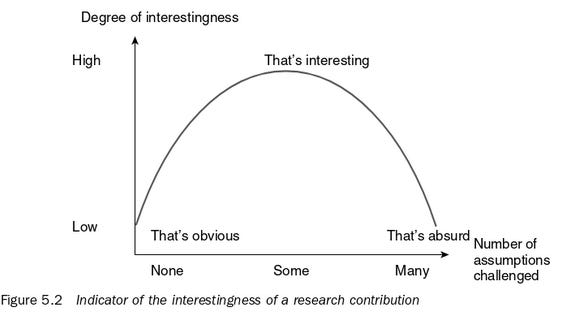
研究におけるギャップ=スポッティング
gap-spotting in research
☆社会のなかで研究者が増大すると、「研究パラダイムの共有」という事柄がおこる。つまり、研究している研究者の頭のなかが、規格化され、研究論題の探求がパズル解きになる傾向である(→「トマス・クーン『科学革命の構造』」)。 そこでの研究者の問題探索は、先行研究の中に各種のギャップを見出し、その穴埋めをするという傾向が増大する。このような、ギャプの穴埋めという「知的行 動」をギャップ・スポッテング(gap-spotting)という。ギャップ・スポッテングという思考法とそれに応える方法論への傾斜は、研究者をして「方法論的フェティシズム」の落とし穴に自らハマってしまう。
★アルベッソンとサンドバーグの主張をまとめてみよう
1)社会科学の論文は総じてつまんない
2)その理由はいろいろ考えられる。論文を書いて業績をあげ、就職したり、職位をあげたりしなればならない、研究者の側の事情である。
3)だが、そのような「つまんない」状況を放置するわけにはいかないとアルベッソンとサンドバーグは考える。
4)なぜなら、そのような「つまんない」状況は、後進の研究者に対して魅力を感じないものにさせると同時に、その研究分野の衰退を生むからである。
5)「つまんない」状況の原因を考えてみよう。その大きな理由は、パラダイムの刷新に向かうのではなく、パラダイムの内部のまだ、十分に研究がされない部分(ギャップ)を埋めよう(スポッテング)とするのが「定番化」しているのが原因だ。
6)ギャップ・スポッテングは、論文を書く側には、無難で査読を通るためには、不可欠な手段にも思える。しかし、最大の問題は、パラダイム内部を埋める、ギャップ・スポッテングは、その研究分野のイノベーションを生まないからだ。
7)パラダイム変革や分野のイノベーションをめざす改善(カイゼン)のための処方を、アルベッソンとサンドバーグは「問題化」という術語で表現する。
8)より具体的には、社会科学の方法論を導くために、「問題化」の刷新が重要であると考えるのである。それを、アルベッソンとサンドバーグは「面白いリサーチ・クエスチョン」を構築することを提案する。
9) 「面白いリサーチ・クエスチョン」を構築することが、それに連鎖して、方法論の新たな模索、解決への道のり、社会との関わりにおける、研究者の役割の再考 に繋がると考えるのである。そのような研究者の姿勢を、アルベッソンとサンドバーグ(2023:201)は「自省的革新者(reflexive inventor)」と呼ぶ。
| Here are some ways to identify research gaps: 1. Look at published literature: Published literature can provide inspiration. 2. Use digital tools: Digital tools can help you find popular topics or research papers that are cited the most. 3. Check journal websites: You can check the websites of influential journals. 4. Analyze systematic literature reviews: Systematic reviews summarize information, answer research questions, and identify gaps in the literature. 5. Consider the population: A population gap occurs when a population is not adequately represented in prior research. 6. Look for disagreement: A disagreement gap occurs when there are conflicting or inconsistent findings in the literature. 7. Consider the empirical evidence: An empirical gap occurs when there is a lack of sufficient empirical evidence or studies in a specific area. 8. Consider the knowledge: A knowledge gap occurs when there is a lack of awareness of theories and literature from related studies. Identifying research gaps is important because it helps inform researchers, policy makers, and funders on what questions need to be addressed and what types of studies are needed. |
研究ギャップを特定する方法をいくつか紹介しよう: 1. 発表された文献を見る: 出版された文献はインスピレーションを与えてくれる。 2. デジタルツールを使う: デジタルツールを使えば、人気のあるトピックや、最も引用されている研究論文を見つけることができる。 3. ジャーナルのウェブサイトをチェックする:影響力のあるジャーナルのウェブサイトをチェックできる。 4. 系統的な文献レビューを分析する: システマティック・レビューは、情報を要約し、研究上の疑問に答え、文献のギャップを明らかにする。 5. 母集団を考慮する: 母集団ギャップとは、ある母集団が先行研究で十分に代表されていない場合に生じる。 6. 意見の相違を探す: 不一致のギャップは、文献に矛盾や一貫性のない知見がある場合に生じる。 7. 経験的証拠を検討する: 経験的なギャップは、特定の分野において十分な経験的証拠や研究がない場合に生じる。 8. 知識を考える: 知識のギャップは、関連する研究の理論や文献に対する認識が不足している場合に生じる。 研究ギャップを特定することは、研究者、政策立案者、資金提供者に、どのような問題に取り組む必要があるのか、どのような種類の研究が必要なのかを知らせるのに役立つため、重要である。 |
| Constructing research questions : doing interesting research, Mats Alvesson & Jörgen Sandberg, SAGE 2013 About the authors vi Preface vii 1 Research questions: a core ingredient in developing interesting theories 1 2 The context of constructing and formulating research questions 10 3 Gap-spotting: the prevalent way of constructing research questions in social science 24 4 A critical evaluation of gap-spotting research: does it lead to interesting theories? 38 5 Problematization as a methodology for generating research questions 47 6 Applying the problematization methodology in practice 71 7 Why does gap-spotting dominate when it reduces the chance to create interesting theories? 92 8 Constructing interesting research questions: problematization and beyond 111 Appendices 124 References 129 Index 139 |
研究課題の構築:興味深い研究を行うために、マツ・アルヴェッソン&ヨルゲン・サンドベリ、SAGE 2013 著者について vi 序文 vii 1 研究課題:興味深い理論構築の核心要素 1 2 研究課題構築・定式化の文脈 10 3 ギャップ発見:社会科学における研究課題構築の主流手法 24 4 ギャップ発見研究の批判的検証:興味深い理論につながるか? 38 5 研究課題を創出する方法論としての問題化 47 6 問題化方法論の実践的適用 71 7 なぜギャップ発見が主流なのか? それは興味深い理論を生み出す機会を減らすのに 92 8 興味深い研究課題の構築:問題化とそれ以降 111 付録 124 参考文献 129 索引 139 |
| Gap-spotting
is a common method of generating research questions by identifying
gaps, or missing information, in existing literature and then
formulating new research to address those gaps. While gap-spotting
helps researchers to add to existing knowledge by identifying neglected
areas, it can also lead to a dominance of studies that simply "fill in
the blanks" rather than challenging underlying assumptions and leading
to more original and influential theories. |
ギャップ・スポッティングとは、既存文献における空白部分や欠落情報を特定し、それらを埋める[spotting の意味]
新たな研究を立案することで研究課題を創出する一般的な手法である。この手法は研究者が見落とされた領域を明らかにすることで既存知識を拡充するのに役立
つ一方で、根底にある前提に疑問を投げかけず単なる「空白埋め」に終始する研究が主流となる危険性もある。その結果、より独創的で影響力のある理論の誕生
が阻害されるのである。 |
| How Gap-Spotting Works 1. Literature Review: Researchers conduct a thorough review of the existing literature on a topic. 2. Identify Gaps: They look for areas where information is missing, inadequate, or overlooked. These gaps can be categorized as: - Confusion spotting: Identifying competing explanations for a phenomenon. - Neglect spotting: Finding topics that have been overlooked or under-addressed. - Application spotting: Noticing a need for a theory to be applied to a new context. 3. Formulate Research Question: A research question is then formulated to fill the identified gap, thereby adding to the existing body of knowledge. |
ギャップ・スポッティングの仕組み 1. 文献レビュー:研究者は対象分野の既存文献を徹底的に調査する。 2. ギャップの特定:情報が不足している、不十分である、あるいは見落とされている領域を探す。これらのギャップは以下のように分類できる: - 混同発見:現象に対する競合する説明を特定すること。 - 見落とし発見:見過ごされたり十分に扱われていないトピックを見つけること。 - 応用発見:理論を新たな文脈へ適用する必要性に気づくこと。 3. 研究課題の策定:特定された空白を埋める研究課題を策定し、既存の知識体系に新たな知見を加える。 |
| Critiques of Gap-Spotting While gap-spotting is a prevalent and useful method, it is also criticized for several reasons: - Limited Innovation: It tends to perpetuate the existing way of thinking and may not lead to fundamentally new or insightful theories. - Assumptions Remain Unchallenged: Gap-spotting often builds on or around existing literature rather than questioning its fundamental assumptions, which limits its potential for radical and influential theoretical development. - Focus on "Filling-in" rather than "Challenging": The primary goal is to add something to what is already known, not to fundamentally rethink established ideas. |
ギャップ・スポッティングへの批判 ギャップ・スポッティングは広く用いられ有用な手法だが、いくつかの理由で批判も受けている: - 革新性の限界:既存の思考様式を永続させる傾向があり、根本的に新しい理論や洞察を生み出せない場合がある。 - 前提が問われない:ギャップ・スポッティングは既存文献を基盤とするか、その周囲で展開されることが多く、その根本的な前提を疑問視しない。そのため、革新的で影響力のある理論的発展の可能性が制限される。 - 「挑戦」ではなく「補完」に焦点が当たる:主な目的は既知の知識に何かを追加することであり、確立された考え方を根本的に再考することではない。 |
| Alternatives to Gap-Spotting - Problematization: This alternative method involves challenging the assumptions underlying existing theories to generate new and fresh research questions and promote critical insights. - Creative Construction of Gaps: Researchers can creatively construct gaps by developing new ideas that challenge existing frameworks, even while adhering to the goal of filling a gap. |
ギャップ・スポッティングの代替手法 - 問題化:この代替手法は、既存理論の根底にある前提に疑問を投げかけることで、新たな研究課題を創出し、批判的洞察を促進する。 - 創造的ギャップ構築:研究者は、既存の枠組みに挑戦する新たなアイデアを構築することで、ギャップを埋めるという目標を堅持しつつ、創造的にギャップを構築できる。 |
☆
| ほとんどすべての研究者が「ギャップ・スポッティング」を使っているが、これは退屈なリサーチ・クエスチョンを生み出すだけのプロセスである ——フロリアン・U・イェーン |
|
| 1. 文献の領域を特定する:
ここで重要なのは、興味のあるトピックで最も影響力のある研究を見つけることである。それらには最も重要な前提が含まれている。ただし、その前提がすでに
誰かによって覆されていないかどうかを確認するために、周辺の文献についても最新の情報を得る必要がある。 2. 前提条件を特定し、明確にする: 通常、前提は明確に示されていないので、それを掘り起こす必要がある。また、前提にはさまざまなスケールがある。ある手法で何ができるかという共通の前提 から、研究分野全体の基礎となる前提まで、さまざまなものがある。掘り起こしたい前提が大きければ大きいほど、私たちは現場から離れなければならない。そ うすることで、前提を見つけるために必要な距離と視点が得られる。ここで、他分野に関する幅広い知識を持つことは、概念の定義がどのように異なる可能性が あるかを浮き彫りにし、根底にある前提にスポットライトを当てることになるため、役に立つ。 3. 明確にした前提を評価する: 仮定を特定したら、今度はそれを詳しく説明する番だ。他の研究者とその前提について議論し、「それは面白い!」と言われれば、挑戦すべき正しい前提を見つ けたことがわかる。このステップでは、あなたが見つけた前提のうち、どの前提をさらに問い詰めたいかを決める必要もある。ここで留意すべきことは、a)範 囲(広ければ広いほどよい)、b)代替となる仮定を思いつくか、c)この仮定への挑戦が社会にとってどの程度重要か、などである。 4. 代替仮定を立てる: 挑戦したい前提が決まったら、世界を説明するのに適した代替の前提を見つけなければならない。ここで重要なのは、新しい仮定に対して真にオープンでなけれ ばならないということだ。自分のバイアスを再現しないようにしたい。そのためには、a)その分野以外の情報源を読む、b)元の仮定を単純に逆転させる、 c)自分とは異なる仮定を持つ人々と話す、などが有効である。 5. 前提を聴衆に関連づける: 仮定に挑戦する前に、人々が仮定を持っているかどうかを確認する必要がある。誰も持っていない前提に挑戦したら、ちょっと残念なことになる。また、仮定に 挑戦することに成功した場合、聴衆や社会にどのような影響を与えるかも考慮しなければならない。 6. あなたが考え出した代替仮定を総合的に評価する: 最初の5つのステップを終えたら、代替仮定のコレクションがこのグラフのどの位置にあるかをチェックしなければならない: |
|
 |
|
| なぜ科学者たちは、より退屈な研究を生み出すにもかかわらず、ギャップ・スポットを多用するのだろうか? 1)制度的条件 2)アカデミアにおける職業規範 3)研究者の性格 |
|
| https://existentialcrunch.substack.com/p/against-the-dominance-of-gap-spotting |
|
| 《逆説》ジャック・ラカンは、ギャップ・スポッティングな手法を一切使わず、ぶっ飛んだ精神分析理論を編み出しながら、かつ、「自分はフロイト主義者である」と言って周りの人たちを煙に巻き、オリジナルな研究を量産した。しかし、ラカンを研究する人たちは、今日、ますます、フロイトとラカンの比較対象や対位法的な読解手法を駆使して、ラカンの何が重要な新らしい貢献なのか?そしてなにが「自分はフロイト主義者である」としてフロイトの理論に自分の理論を係留することに細心の注意を払ったのか?、それを見守っている。 |
☆アネクドート
| 中国の科学研究論文の数は世界一なのに、なぜノーベル賞を取れないのか?―仏メディア, 2025年10月20日 |
|
| ■仏国際放送局ラジオ・フランス・アンテルナショナル(RFI)中国語版は19日、「中国の科学研究論文の数は世界一なのにノーベル賞とは無縁、原因はどこに?」と題する記事を掲載した。 ■記事は、今年のノーベル賞受賞者が発表され、大阪大学の坂口志文氏が生理学・医学賞を、京都大学の北川進氏が化学賞を受賞したことを説明。日本が 2001年に掲げた「50年で30個のノーベル賞」の目標は25年で約8割を達成しており、中国のSNS上で大きな話題になったと伝えた。 ■そして、日本が着実に受賞していく中、「中国は科学研究論文数で世界一なのに、なぜノーベル賞を取れないのか」という疑問の声が上がったと言及。実際、 論文数では23年に米国を抜いて世界一になっており、24年の(中国の)研究開発費は米国に次いで2番目に多い3兆6000億元(約73兆円)と世界全体 のおよそ20%に上っていると紹介した。 ■また、23年のハイレベル学術誌での論文発表は世界の約3分の1に当たる11万本超で、24年の引用数の多い注目論文数でも48.4%を占め世界1位を過去数年に渡り維持していることにも触れた。 ■その上で、こうした状況にもかかわらず中国がノーベル賞をなかなか取れない理由について、ネットユーザーの興味深い見解を紹介した。あるユーザーは 「1949年から現在まで、日本人が受けたノーベル賞はおよそ32件。日本をどれだけ憎んでも、それで日本が民生、医療、食品安全、映画・音楽、官僚の清 廉さ、治安、科学技術、教育、さらにはサッカーにおいてもはるかに先を行っている事実は変わらない」と書き込んだ。 |
|
| https://topics.smt.docomo.ne.jp/article/recordchina/business/recordchina-RC_962389?page=1 |
|
| ■また、別のユーザーは「毎年この時期に、わが国では奇妙な『集団ヒス
テリー』が起きるが、痛いところには一切触れない。今年のノーベル生理学・医学賞は、私たちの偽善的な仮面を粉々に打ち砕いた。受賞した3人は誰1人とし
て論文の山を築いたわけでも、大規模なチームを従えていたわけでもない。彼らはただ、ひたむきに本当に重要な科学的課題を探求し続けてきただけだ。しか
し、私たち(中国人)の研究動機は、すでに『プロジェクト予算表の数字ゲーム』へと変質してしまっている。研究課題が立ち上がったその日から、あらゆる思
考はKPI(重要業績評価指標)を中心に回り出す」と論じた。 ■そして、「私たちの研究テーマの多くは自然への問いかけから生まれるのではなく、綿密な計算に基づいた『合理的選択』から生まれている。どの分野なら成 果が出やすいか?どんな題材なら審査員の好みに合うか?こうしたビジネス論理に堕ちてしまえば、科学探究の最も基本となる原動力である『好奇心』は、最初 に切り捨てられることになる」と述べた。 ■同ユーザーは、坂口氏が制御性T細胞の発見当時あまり理解されなかったことを例に「本当のイノベーションはその先進性ゆえにしばしば体制の理解を得られ ない側面もある」と言及。一方で、中国のような科学研究システムの中にあっては、「後ろ盾を持たない若い才能ある研究者たちは際限のない申請書類の作成に 才能をすり減らすか、あるいはこの不条理なゲームに加わるしかなくなる。私たちの莫大な研究投資は、最終的に科学そのものの進歩ではなく、無数の『学術帝 国』を肥え太らせる結果になっている」と断じた。 ■その上で、「論文の数で研究レベルを競い、インパクトが学問的価値と同義にされ、研究費の多寡が能力の証明とされる社会では、研究者たちが指標 (KPI)の追求にすべての精力を注ぐのは当然だ。論文の総量では世界トップクラスに躍り出たものの、真に独創的なブレークスルーは数えるほどしかなく、 人気分野には人が殺到する一方で、地味な研究分野は閑散としている。『作業員』が大量生産される一方で、本物の科学者はごくわずかだ」とし、「ノーベル賞 に何度も横っ面をひっぱたかれてきたが、私たちはいまだに目を覚まさない」と自国の状況に苦言を呈したという。(翻訳・編集/北田) |
|
| https://topics.smt.docomo.ne.jp/article/recordchina/business/recordchina-RC_962389?page=2 |
リ ンク
文 献
そ の他の情報
Copyleft,
CC, Mitzub'ixi Quq Chi'j, 1996-2099